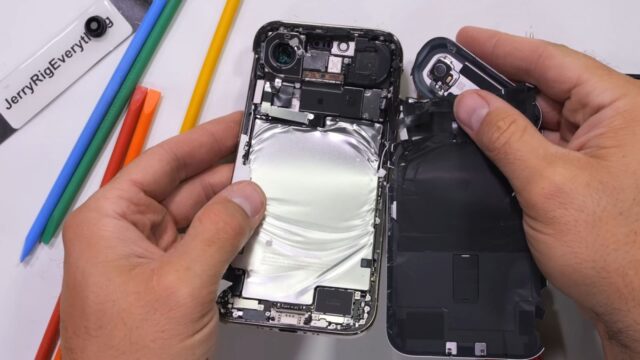
The newly launched iPhone Air, which Apple has been promoting mainly for its thin and lightweight design, has now been taken apart. A full teardown from iFixit gives a rare look inside the device, showing how Apple managed to fit powerful hardware into such a slim frame. The findings highlight a mix of clever engineering, compromises, and some choices that might frustrate anyone who cares about repairability.
According to iFixit’s breakdown, the interior is tightly packed, featuring a redesigned logic board, a custom battery shape, and a thermal cooling system that Apple hasn’t used before in its non-Pro models.
Key Takeaways
- The iPhone Air uses a smaller, L-shaped battery with a capacity of 3,120 mAh.
- A new vapor chamber cooling system helps manage heat inside the thinner body.
- The logic board is more compact, with several components soldered directly, limiting repair flexibility.
- iFixit assigned the device a repairability score of 4 out of 10.
One of the first things that stands out in the teardown is the custom L-shaped battery. Apple designed it specifically to fit the slimmer frame, but at 3,120 mAh, it’s a step down from the 3,349 mAh battery in the standard iPhone. It’s not a huge drop, but it does make you wonder if users will notice shorter battery life in daily use. It seems like one of those trade-offs where design took priority over endurance, and that has already become a talking point among early buyers.
Another interesting discovery lies beneath the display. Apple included a vapor chamber cooling system, which isn’t something we usually see in its regular iPhone lineup. This type of system is more common in gaming phones or high-end Android devices, as it uses a small amount of liquid sealed inside a chamber to move heat away from the main processor. In this case, that’s the new A19 Bionic chip. Its addition feels almost necessary given how thin the iPhone Air is and how little space there is for heat to escape.
The logic board itself has also been reshaped and made smaller. iFixit noted that several parts, like the Wi-Fi and Bluetooth controllers, are now integrated directly onto the board. From an engineering perspective, it’s a neat way to save space, but it comes at a cost. If one of these components fails, the repair might mean replacing the entire board instead of just one part, which is far more expensive. It’s an efficiency gain for Apple, but perhaps not for the consumer.
Altogether, the combination of adhesives, soldered components, and custom-shaped parts led iFixit to give the iPhone Air a repairability score of just 4 out of 10. That’s on the low end, and it suggests that unless you’re armed with the right tools and parts directly from Apple, fixing this device could be a real challenge. It’s another example of the ongoing tension in smartphone design, where pushing for sleekness and compactness often leaves repairability behind.
Frequently Asked Questions (FAQs)
Q1: What is the battery capacity of the new iPhone Air?
A. The iPhone Air teardown confirms it has a custom L-shaped battery with a capacity of 3,120 mAh, which is smaller than the battery in the standard iPhone model.
Q2: How does the iPhone Air stay cool with such a thin design?
A. The phone uses a vapor chamber cooling system. This system helps to spread and dissipate heat generated by the processor within the slim body, preventing the device from getting too hot during use.
Q3: Is the iPhone Air easy to repair?
A. According to the iFixit teardown, the iPhone Air is difficult to repair, earning a score of 4 out of 10. The use of strong glue and components soldered directly to the main board makes replacing individual parts very challenging.
Q4: What is a logic board in an iPhone?
A. The logic board is the main circuit board inside the iPhone. It holds the most important components, including the main processor (CPU), memory (RAM), and storage, connecting all parts of the phone so they can work together.
Q5: Why is a lower repairability score a concern for consumers?
A. A lower repairability score means that fixing the device is more difficult and often more expensive. It can limit repair options to the original manufacturer, reduce the device’s lifespan, and contribute to more electronic waste.










